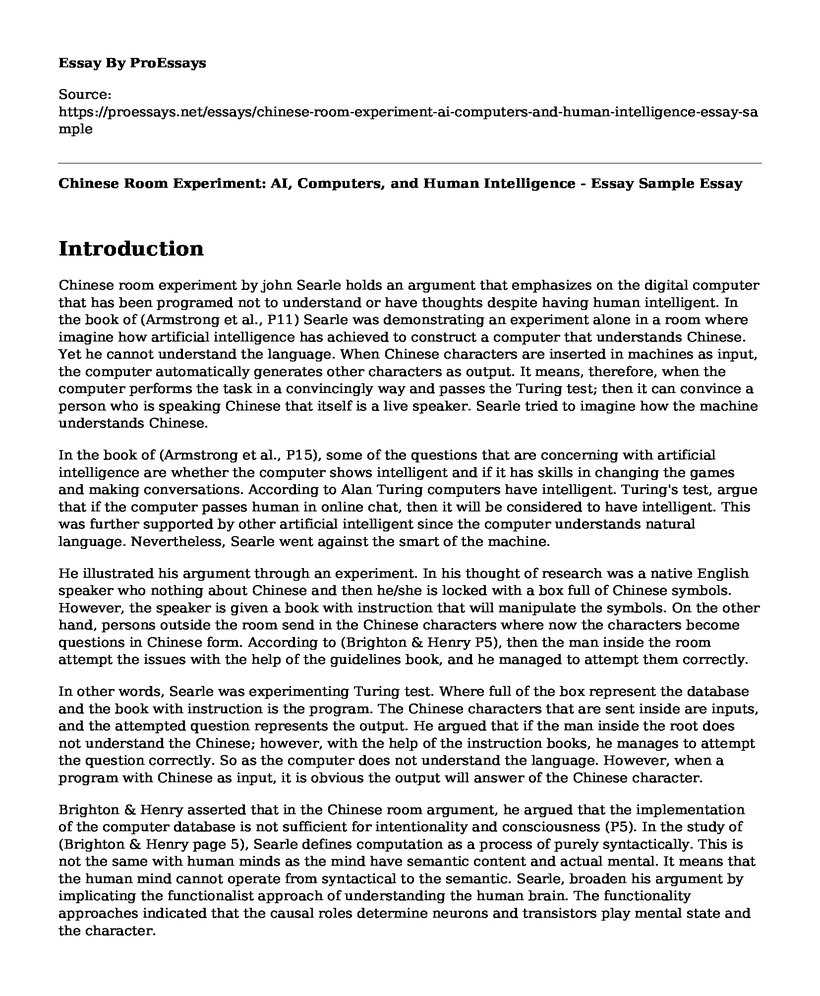Introduction
Chinese room experiment by john Searle holds an argument that emphasizes on the digital computer that has been programed not to understand or have thoughts despite having human intelligent. In the book of (Armstrong et al., P11) Searle was demonstrating an experiment alone in a room where imagine how artificial intelligence has achieved to construct a computer that understands Chinese. Yet he cannot understand the language. When Chinese characters are inserted in machines as input, the computer automatically generates other characters as output. It means, therefore, when the computer performs the task in a convincingly way and passes the Turing test; then it can convince a person who is speaking Chinese that itself is a live speaker. Searle tried to imagine how the machine understands Chinese.
In the book of (Armstrong et al., P15), some of the questions that are concerning with artificial intelligence are whether the computer shows intelligent and if it has skills in changing the games and making conversations. According to Alan Turing computers have intelligent. Turing's test, argue that if the computer passes human in online chat, then it will be considered to have intelligent. This was further supported by other artificial intelligent since the computer understands natural language. Nevertheless, Searle went against the smart of the machine.
He illustrated his argument through an experiment. In his thought of research was a native English speaker who nothing about Chinese and then he/she is locked with a box full of Chinese symbols. However, the speaker is given a book with instruction that will manipulate the symbols. On the other hand, persons outside the room send in the Chinese characters where now the characters become questions in Chinese form. According to (Brighton & Henry P5), then the man inside the room attempt the issues with the help of the guidelines book, and he managed to attempt them correctly.
In other words, Searle was experimenting Turing test. Where full of the box represent the database and the book with instruction is the program. The Chinese characters that are sent inside are inputs, and the attempted question represents the output. He argued that if the man inside the root does not understand the Chinese; however, with the help of the instruction books, he manages to attempt the question correctly. So as the computer does not understand the language. However, when a program with Chinese as input, it is obvious the output will answer of the Chinese character.
Brighton & Henry asserted that in the Chinese room argument, he argued that the implementation of the computer database is not sufficient for intentionality and consciousness (P5). In the study of (Brighton & Henry page 5), Searle defines computation as a process of purely syntactically. This is not the same with human minds as the mind have semantic content and actual mental. It means that the human mind cannot operate from syntactical to the semantic. Searle, broaden his argument by implicating the functionalist approach of understanding the human brain. The functionality approaches indicated that the causal roles determine neurons and transistors play mental state and the character.
The argument was to encounter the computational theory, which views as an information process. From the view of Searle in the philosophy of computational, functionalism and biological naturalism, the human mind can equate with a computer program. More so, artificial intelligence cannot produce an application which can exactly resemble human beings. Hence a computer cannot be intelligent; instead, its function through the human mind.
Work Cited
Armstrong, Stuart, and Kaj Sotala. "How we're predicting AI-or failing to." Beyond artificial intelligence. Springer, Cham, 2015. 11-29.
Brighton, Henry. Introducing Artificial Intelligence: A Graphic Guide. Icon Books Ltd, 2015.
Cite this page
Chinese Room Experiment: AI, Computers, and Human Intelligence - Essay Sample. (2023, Mar 03). Retrieved from https://proessays.net/essays/chinese-room-experiment-ai-computers-and-human-intelligence-essay-sample
If you are the original author of this essay and no longer wish to have it published on the ProEssays website, please click below to request its removal:
- Epistemology Essay
- Moral Concerns and Committing Suicide Essay Example
- Paper Example on Multicomponent Distillation
- Comparing Plato's Allegory of the Cave to a Real-Life Situation
- Essay on Pizza Hut Reaps Benefits From Technology: Innovative Sales Processes
- Ethical Issues in Proposing GameRush, Inc: Upholding Professionalism - Essay Sample
- Essay Example on Exploring the Green Infrastructure of Tbilisi Region







